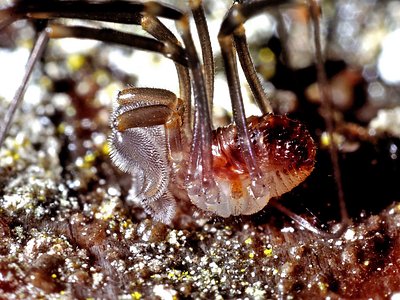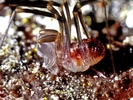Ischyropsalidoidea
Axel Schönhofer


This tree diagram shows the relationships between several groups of organisms.
The root of the current tree connects the organisms featured in this tree to their containing group and the rest of the Tree of Life. The basal branching point in the tree represents the ancestor of the other groups in the tree. This ancestor diversified over time into several descendent subgroups, which are represented as internal nodes and terminal taxa to the right.

You can click on the root to travel down the Tree of Life all the way to the root of all Life, and you can click on the names of descendent subgroups to travel up the Tree of Life all the way to individual species.
For more information on ToL tree formatting, please see Interpreting the Tree or Classification. To learn more about phylogenetic trees, please visit our Phylogenetic Biology pages.
close boxIntroduction
Ischyropsalidoidea is defined as group of Dyspnoi with a penis operated by a single muscle (Martens 1976, Martens et al. 1981). They lack clavate hairs on the palps, the ovipositor is short, secondarily unsegmented, with an undivided furca (Martens 1976) and a common channel for cement glands (Martens et al. 1981). Some members possess metapeltidial sensory cones (Shear 1986) that have an unknown function. Further characters are hard to establish for the high morphological divergence of the included taxa. Many characters used in older approaches appear plesiomorphic or convergent (Gruber 2007).
Taxonomy and Discussion of Phylogenetic Relationships
Ischyropsalidoidea has been proposed as family since Simon (1879) and was redefined as superfamily by Martens (1976) and Martens et al. (1981). It is accepted as monophyletic, supported by molecular analyses (e.g. Giribet et al. 2010) and morphology (Shear 1986, Gruber 2007). The Ischyropsalidoidea include very heterogeneous taxa hard to place in a morphology based phylogenetic framework. The cladistic analysis by Shear (1986) organized them within three accepted families but the arrangement of genera was questioned by Giribet et al. (2010) based on molecular results, combining both approaches does not clarify the position of all genera.
Ecology and Life History
General trends within Ischyropsalididae show preference to permanently wet and cool to cold habitats. This preference has led to a respective number of cave inhabiting species and alpine endemics, while true troglobionts, lacking eyes, are rare. Most species show a distinct phenology of adults being present only during a short time of the year, mostly from summer to late autumn, but cave species can occur year round.
References
Giribet, G., Vogt, L. Pérez-González, A., Sharma, P. and A. B. Kury. 2010. A multilocus approach to harvestman (Arachnida: Opiliones) phylogeny with emphasis on biogeography and the systematics of Laniatores. Cladistics 26:408-437.
Gruber, J. 2007. Dyspnoi - Historical systematic synopsis. In: Pinto-da-Rocha, R., Machado, G., & Giribet, G. (eds.), Harvestmen: the biology of Opiliones. Harvard University Press, Cambridge:131-135.
Martens, J. 1976. Genitalmorphologie, System und Phylogenie der Weberknechte (Arachnida: Opiliones). Entomologica Germanica 3(1/2):51-68.
Martens, J., Hoheisel, U. and M. Götze 1981. Vergleichende Anatomie der Legeröhren der Opiliones als Beitrag zur Phylogenie der Ordnung (Arachnida). Zoologische Jahrbücher, Abteilung für Anatomie und Ontogenie der Tiere 105(1):13-76.
Shear, W. A. 1986. A cladistic analysis of the opilionid superfamily Ischyropsalidoidea, with descriptions of the new family Ceratolasmatidae, the new genus Acuclavella, and four new species. American Museum Novitates 2844:1-29.
Simon, E. 1879. Contenant les ordres des Chernetes, Scorpiones et Opiliones. Les Arachnides de France 7:1-332.
Title Illustrations

| Scientific Name | Ischyropsalis lithoclasica |
|---|---|
| Specimen Condition | Live Specimen |
| Identified By | Axel Schoenhofer |
| Sex | f |
| Life Cycle Stage | adult |
| Copyright |
© 2011 Axel Schönhofer

|
| Scientific Name | Sabacon sp |
|---|---|
| Specimen Condition | Live Specimen |
| Identified By | Axel Sch?nhofer |
| Life Cycle Stage | juvenile |
| Copyright |
© 2011 Axel Schönhofer

|
About This Page
Many thanks to Angela DiDomenico for the final English check.
Axel Schönhofer

San Diego States University, San Diego, California, USA
Correspondence regarding this page should be directed to Axel Schönhofer at
Axel.Schoenhofer@uni-mainz.de
Page copyright © 2012 Axel Schönhofer
 Page: Tree of Life
Ischyropsalidoidea .
Authored by
Axel Schönhofer .
The TEXT of this page is licensed under the
Creative Commons Attribution-NonCommercial License - Version 3.0. Note that images and other media
featured on this page are each governed by their own license, and they may or may not be available
for reuse. Click on an image or a media link to access the media data window, which provides the
relevant licensing information. For the general terms and conditions of ToL material reuse and
redistribution, please see the Tree of Life Copyright
Policies.
Page: Tree of Life
Ischyropsalidoidea .
Authored by
Axel Schönhofer .
The TEXT of this page is licensed under the
Creative Commons Attribution-NonCommercial License - Version 3.0. Note that images and other media
featured on this page are each governed by their own license, and they may or may not be available
for reuse. Click on an image or a media link to access the media data window, which provides the
relevant licensing information. For the general terms and conditions of ToL material reuse and
redistribution, please see the Tree of Life Copyright
Policies.
- First online 08 July 2012
- Content changed 08 July 2012
Citing this page:
Schönhofer , Axel. 2012. Ischyropsalidoidea . Version 08 July 2012 (under construction). http://tolweb.org/Ischyropsalidoidea/60680/2012.07.08 in The Tree of Life Web Project, http://tolweb.org/







 Go to quick links
Go to quick search
Go to navigation for this section of the ToL site
Go to detailed links for the ToL site
Go to quick links
Go to quick search
Go to navigation for this section of the ToL site
Go to detailed links for the ToL site